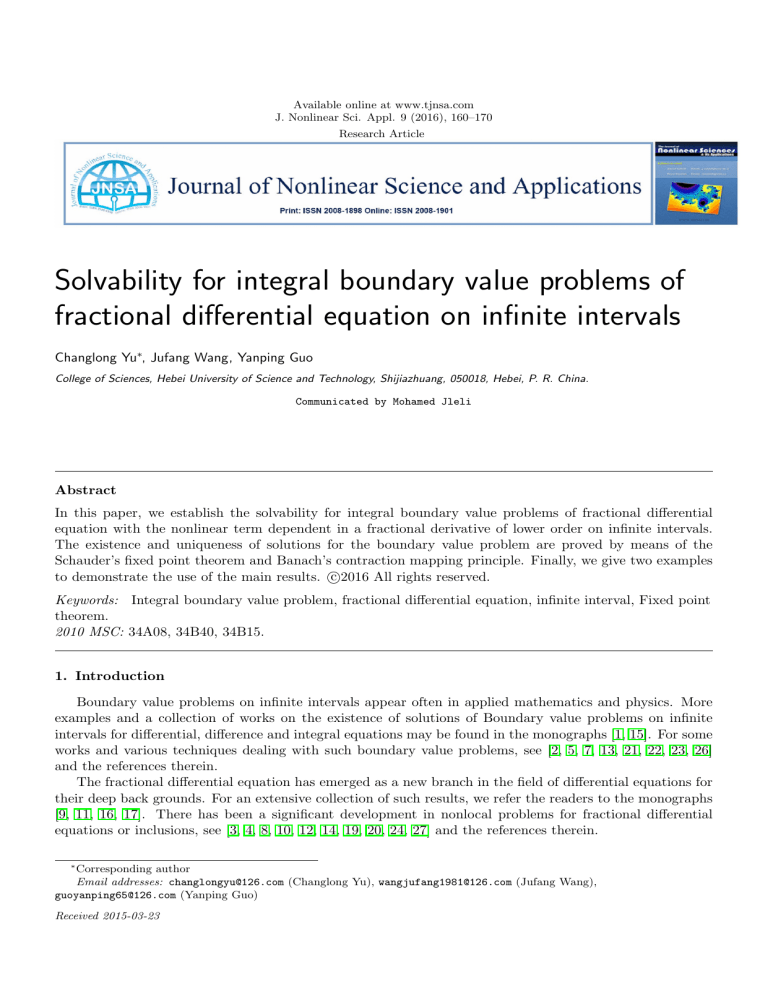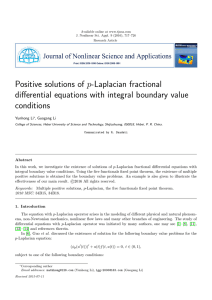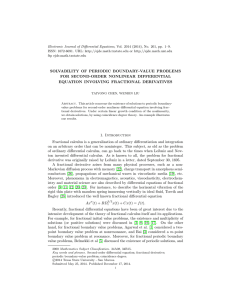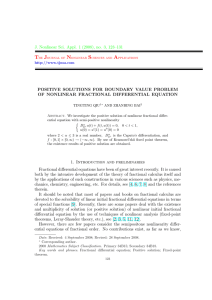
Available online at www.tjnsa.com
J. Nonlinear Sci. Appl. 9 (2016), 160–170
Research Article
Solvability for integral boundary value problems of
fractional differential equation on infinite intervals
Changlong Yu∗, Jufang Wang, Yanping Guo
College of Sciences, Hebei University of Science and Technology, Shijiazhuang, 050018, Hebei, P. R. China.
Communicated by Mohamed Jleli
Abstract
In this paper, we establish the solvability for integral boundary value problems of fractional differential
equation with the nonlinear term dependent in a fractional derivative of lower order on infinite intervals.
The existence and uniqueness of solutions for the boundary value problem are proved by means of the
Schauder’s fixed point theorem and Banach’s contraction mapping principle. Finally, we give two examples
to demonstrate the use of the main results. c 2016 All rights reserved.
Keywords: Integral boundary value problem, fractional differential equation, infinite interval, Fixed point
theorem.
2010 MSC: 34A08, 34B40, 34B15.
1. Introduction
Boundary value problems on infinite intervals appear often in applied mathematics and physics. More
examples and a collection of works on the existence of solutions of Boundary value problems on infinite
intervals for differential, difference and integral equations may be found in the monographs [1, 15]. For some
works and various techniques dealing with such boundary value problems, see [2, 5, 7, 13, 21, 22, 23, 26]
and the references therein.
The fractional differential equation has emerged as a new branch in the field of differential equations for
their deep back grounds. For an extensive collection of such results, we refer the readers to the monographs
[9, 11, 16, 17]. There has been a significant development in nonlocal problems for fractional differential
equations or inclusions, see [3, 4, 8, 10, 12, 14, 19, 20, 24, 27] and the references therein.
∗
Corresponding author
Email addresses: changlongyu@126.com (Changlong Yu), wangjufang1981@126.com (Jufang Wang),
guoyanping65@126.com (Yanping Guo)
Received 2015-03-23
C. Yu, J. Wang, Y. Guo, J. Nonlinear Sci. Appl. 9 (2016), 160–170
161
Boundary value problems for fractional differential equations on infinite intervals have been considered
widely and there are some excellent results on the existence of solutions, see [6, 18, 25] and the references
therein. However, to our knowledge, it is rare for works to be done on the solutions for integral boundary
value problems (IBVPs) of fractional differential equations on infinite interval.
Recently, in [18], X. Su and S. Zhang considered the BVP:
α
D0+ u(t) = f (t, u(t), D0α−1
t ∈ J := [0, +∞),
+ u(t)),
α−1
u(0) = 0, D0+ u(∞) = u∞ ,
u∞ ∈ R,
where 1 < α ≤ 2, f ∈ C(J × R × R, R),D0α+ and D0α−1
are the standard Riemann-Liouville fractional
+
derivatives. The existence of unbounded positive solutions was obtained by the Schauder’s fixed point
theorem on unbounded domain.
Motivated by the work above, in this paper, we will discuss the following IBVP:
(
D0α+ u(t) = f (t, u(t), D0α−1
t ∈ J,
+ u(t)),
R +∞
(1.1)
u(0) = 0, D0α−1
u(∞)
=
g(t)u(t)dt,
+
η
R +∞
where J = [0, +∞), 1 < α ≤ 2, f ∈ C(J ×R×R, R), η ≥ 0, g(t) ∈ L1 [0, +∞) and η g(t)tα−1 dt < Γ(α),
α−1
D0α+ and D0α−1
are the standard Riemann-Liouville fractional derivatives and D0α−1
+
+ u(∞) = lim D0+ u(t).
t→+∞
We deal with the existence and uniqueness of solutions for BVP (1.1) by using the Schauder’s fixed
point theorem and Banach’s contraction mapping principle and obtain multiplicity results which extend and
improve the known results.
2. Preliminary results
In this section, we introduce definitions and preliminary facts which are used throughout paper. Following, let us recall some basic concepts of fractional calculus, see [9, 16, 17] and the references therein.
Definition 2.1. The Riemann-Liouville fractional integral of order δ > 0 of a function f (t) is defined by
Z t
1
δ
Ia+ f (t) =
(t − s)δ−1 f (s)ds,
t > a,
Γ(δ) a
provided that the right-hand side is pointwise defined.
It is well known that Iaδ+ f (a) = 0, for f (t) ∈ C[a, b],δ > 0 and Iaδ+ : C[a, b] → C[a, b] for δ > 0.
Definition 2.2. The Riemann-Liouville fractional derivative of order δ > 0 of a function f (t) is defined by
n
n Z t
1
d
d
n−δ
δ
Da+ f (t) =
Ia+ f (t) =
(t − s)n−δ−1 f (s)ds,
t > a,
dt
Γ(n − δ) dt
a
where n is the smallest integer greater than or equal to δ, provided that the right-hand side is pointwise
defined. In particular, for δ = n, Dan+ f (t) = f (n) (t).
Lemma 2.3 ([9]). In this work, we need the following composition relations:
(a) Daδ + Iaδ+ f (t) = f (t), δ > 0,
f (t) ∈ L1 [0, +∞);
(b) Daδ + Iaγ+ f (t) = Iaγ−δ
γ > δ > 0,
+ f (t),
f (t) ∈ L1 [0, +∞).
Definition 2.4 ([13]). It holds that f : [0, ∞) × R2 → R is called an S-Carathéodory function if and only if
(i) for each (u, v) ∈ R2 , t ∈ f (t, u, v) is measurable on [0, ∞);
(ii) for almost every t ∈ [0, ∞), (u, v) 7→ f (t, u, v) is continuous on R2 ;
(iii) for each r > 0, there exist ϕr (t) ∈ L1 [0, ∞), ϕr (t) > 0 on [0, ∞) such that max{|u|, |v|} ≤ r implies
|f (t, u, v)| ≤ ϕr (t), f or a.e. t ∈ [0, ∞).
C. Yu, J. Wang, Y. Guo, J. Nonlinear Sci. Appl. 9 (2016), 160–170
162
Lemma 2.5 ([18]). For δ > 0, the equation Daδ + x(t) = 0 is valid if and only if, x(t) = Σnj=1 cj (t − a)δ−j ,
where cj ∈ R, j = 1, 2, · · · , n are arbitrary constants and n is the smallest integer greater than or equal to
δ.
R +∞
Lemma 2.6. Let y(t) ∈ L1 [0, +∞) and η g(t)tα−1 dt 6= Γ(α), then IBVP
(
D0α+ u(t) = y(t),
t ∈ J,
R +∞
α−1
u(0) = 0, D0+ u(∞) = η g(t)u(t)dt,
has a unique soltuion
Z
+∞
G(t, s)y(s)ds,
u(t) =
0
where
G(t, s) =
(
1
R +∞
g(t)tα−1 dt)
R +∞
[H(η, s) − Γ(α)]tα−1 + (Γ(α) − η g(t)tα−1 dt)(t − s)α−1 ,
[H(η, s) − Γ(α)]tα−1 ,
Γ(α)(Γ(α) −
and
η
( R
+∞
g(t)(t − s)α−1 dt,
η
R +∞
H(η, s) =
g(t)(t − s)α−1 dt,
s
s ≤ t,
s ≥ t,
s ≤ η,
s ≥ η.
Proof. We may apply Lemma 2.5 to reduce the differential equation in (2.1) to the integral equation
u(t) = c1 tα−1 + c2 tα−2 +
1
Γ(α)
t
Z
(t − s)α−1 y(s)ds.
0
α−1 = Γ(α), we have
In accordance with Lemma 2.3, Lemma 2.5 and the relation D0α−1
+ t
D0α−1
+ u(t)
Z
= c1 Γ(α) +
t
y(s)ds.
0
The boundary condition in (2.1) imply that c2 = 0 and
R +∞
R +∞
H(η, s)y(s)ds − Γ(α) 0 y(s)ds
0
c1 =
,
R +∞
Γ(α)(Γ(α) − β η g(t)tα−1 dt)
where
( R
+∞
g(t)(t − s)α−1 dt,
Rη+∞
H(η, s) =
g(t)(t − s)α−1 dt,
s
s ≤ η,
s ≥ η.
Hence,
R +∞
0
u(t) =
Z
=
R +∞
Z t
H(η, s)y(s)ds − Γ(α) 0 y(s)ds α−1
1
t
+
(t − s)α−1 y(s)ds
R +∞
α−1
Γ(α)
Γ(α)(Γ(α) − η g(t)t
dt)
0
+∞
G(t, s)y(s)ds.
0
This proof is complete.
(2.1)
C. Yu, J. Wang, Y. Guo, J. Nonlinear Sci. Appl. 9 (2016), 160–170
Lemma 2.7. Let
R +∞
η
163
g(t)tα−1 dt < Γ(α),then
2tα−1
.
R +∞
Γ(α) − η g(t)tα−1 dt
|G(t, s)| ≤
(2.2)
Proof. Obviously, it holds
Z
+∞
0 ≤ H(η, s) ≤
g(t)tα−1 dt,
η
therefore, when s ≤ t, then
|G(t, s)| ≤
≤
(
R +∞
η
R +∞
g(t)tα−1 dt + Γ(α))tα−1 + (Γ(α) − η g(t)tα−1 dt)tα−1
R +∞
Γ(α)(Γ(α) − η g(t)tα−1 dt)
2tα−1
.
R +∞
Γ(α) − η g(t)tα−1 dt
Obviously, when s ≥ t, (2.2) holds. This proof is complete.
Remark 2.8. By Lemma 2.6, it is easy to get
Z
D0α−1
+ u(t)
+∞
G1 (t, s)y(s)ds,
=
0
where
G1 (t, s) =
and if
R +∞
η
(
1
Γ(α) −
R +∞
η
g(t)tα−1 dt
R +∞
H(η, s) − η g(t)tα−1 dt,
H(η, s) − Γ(α),
s ≤ t,
s ≥ t,
g(t)tα−1 dt < Γ(α), then
|G1 (t, s)| ≤
2Γ(α)
.
R +∞
Γ(α) − η g(t)tα−1 dt
(2.3)
Define the spaces by
X = {u(t) ∈ C(J, R) : sup
t∈J
|u(t)|
< +∞},
1 + tα−1
C∞ = {u(t) ∈ X : D0α−1
sup |D0α−1
+ u(t) ∈ C(J, R),
+ u(t)| < +∞},
t∈J
|u(t)|
|u(t)|
α−1
and the norm kukX = sup 1+t
α−1 , kuk = max{sup 1+tα−1 , sup |D0+ u(t)|}.
t∈J
t∈J
t∈J
Lemma 2.9 ([18]). (X, k · kX ) and (C∞ , k · k) are Banach spaces.
Define operator T : C∞ → C∞ ,
Z
T u(t) :=
0
+∞
G(t, s)f (s, u(s), D0α−1
+ u(s))ds,
(2.4)
and
R +∞
D0α−1
+ T u(t)
=
0
Z
+
Z
=
0
R +∞
H(η, s)f (s, u(s), D0α−1
f (s, u(s), D0α−1
+ u(s))ds − Γ(α) 0
+ u(s))ds
R +∞
Γ(α) − η g(t)tα−1 dt
t
0
+∞
f (s, u(s), D0α−1
+ u(s))ds
G1 (t, s)f (s, u(s), D0α−1
+ u(s))ds.
(2.5)
C. Yu, J. Wang, Y. Guo, J. Nonlinear Sci. Appl. 9 (2016), 160–170
164
In this paper, our basic space is C∞ . Note that the Arzela-Ascoli theorem fails to work in C∞ . Therefore,
we need the following compactness criterion.
Lemma 2.10 ([18]). Let Z ⊆ Y be a bounded set, then Z is relatively compact in Y if the following
conditions hold:
u(t)
α−1
(i) For any u(t) ∈ Z, 1+t
α−1 and D0+ u(t) are equicontinuous on any compact interval of J;
(ii) Given ε > 0, there exists a constant T = T (ε) > 0 such that
u(t1 )
u(t2 )
<ε
α−1 −
1 + t1
1 + t2α−1
α−1
|D0α−1
+ u(t1 ) − D0+ u(t2 )| < ε
and
for any t1 , t2 ≥ T and u(t) ∈ Z.
3. Main results
In this section, we apply fixed point theorem to IBVP (1.1). First, we give the uniqueness result based
on Banach’s contraction mapping principle.
Theorem 3.1. Let f : J × R2 → R be an S-Caratheodory function and there exist L1 (t), L2 (t) ∈ L1 [0, +∞)
such that
|f (t, u1 , v1 ) − f (t, u2 , v2 )| ≤ L1 (t)|u1 − u2 | + L2 (t)|v1 − v2 |, t ∈ I, (u1 , v1 ), (u2 , v2 ) ∈ R2 .
In addition, suppose that Λ < 1 holds, where
Λ=
Γ(α) −
R +∞
η
+∞
Z
2
g(t)tα−1 dt
[(1 + tα−1 )L1 (t) + L2 (t)]dt.
0
Then IBVP (1.1) has a unique solution.
Proof. Let us choose
r≥
Γ(α) −
R +∞
η
g(t)tα−1 dt
R +∞
ϕr (t)dt
.
R +∞
− 2 0 [(1 + tα−1 )L1 (t) + L2 (t)]dt
2
0
Now, we show that T Br ⊂ Br , where Br = {u ∈ C∞ : kuk ≤ r}.
For each u ∈ Br , we have
Z +∞
|T u(t)|
|G(t, s)|
=
| f (s, u(s), D0α−1
+ u(s)) | ds
α−1
1+t
1 + tα−1
0
Z +∞
2
≤
|f (s, u(s), D0α−1
R +∞
+ u(s))|ds
α−1
Γ(α) − η g(t)t
dt 0
Z +∞ 2
α−1
≤
|f (s, u(s), D0+ u(s)) − f (s, 0, 0)| + |f (s, 0, 0)| ds
R +∞
Γ(α) − η g(t)tα−1 dt 0
Z +∞
Z +∞
2
α−1
≤
||u||
[(1 + t
)L1 (t) + L2 (t)]dt +
ϕr (t)dt
R +∞
Γ(α) − η g(t)tα−1 dt
0
0
≤ r,
and
|D0α−1
+ T u(t)| ≤
2Γ(α)
R +∞
Γ(α) − η g(t)tα−1 dt
Z
0
+∞
|f (s, u(s), D0α−1
+ u(s))|ds ≤ Γ(α)r ≤ r.
C. Yu, J. Wang, Y. Guo, J. Nonlinear Sci. Appl. 9 (2016), 160–170
165
Hence, we obtain that ||T u|| ≤ r, so T Br ⊂ Br .
Next, for u, v ∈ C∞ and for each t ∈ J, we have
Z +∞
T u(t)
T v(t)
1
α−1
G(t, s)(f (s, u(s), D0α−1
−
=
+ u(s)) − f (s, v(s), D0+ v(s)))ds
1 + tα−1 1 + tα−1
1 + tα−1 0
Z +∞
2
α−1
≤
|f (s, u(s), D0α−1
R +∞
+ u(s)) − f (s, v(s), D0+ v(s))|ds
Γ(α) − η g(t)tα−1 dt 0
Z +∞ 2
L1 (s)|u1 (s) − u2 (s)| + L2 (s)|v1 (s) − v2 (s)| ds
≤
R +∞
Γ(α) − η g(t)tα−1 dt 0
Z +∞
2
≤
[(1 + tα−1 )L1 (t) + L2 (t)]dt||u − v||
R +∞
Γ(α) − η g(t)tα−1 dt 0
≤ Λ||u − v|| < ||u − v||,
and
|D0α−1
+ T u(t)
−
D0α−1
+ T v(t)|
+∞
Z
α−1
G1 (t, s)(f (s, u(s), D0α−1
+ u(s)) − f (s, v(s), D0+ v(s)))ds
Z +∞
2Γ(α)
α−1
≤
|f (s, u(s), D0α−1
R +∞
+ u(s)) − f (s, v(s), D0+ v(s))|ds
Γ(α) − η g(t)tα−1 dt 0
=
0
< Γ(α)||u − v|| ≤ ||u − v||.
Therefore, we obtain that ||T u − T v|| < ||u − v||, T is a contraction map. Thus, the conclusion of the
theorem follows by Bananch’s contraction mapping principle. The next existence result is based on the Schauder’s fixed-point theorem.
Theorem 3.2. Assume that there exists nonnegative functions p(t), q(t), r(t) ∈ L1 (J, R+ ) with tα−1 p(t) ∈
L1 (J, R+ ) such that
|f (t, u, v)| ≤ p(t)|u| + q(t)|v| + r(t), t ∈ J, (u, v) ∈ R2 .
(3.1)
Then BVP (1.1) has at least one solution provided
Z
0
+∞ R +∞
g(t)tα−1 dt
Γ(α)
−
η
.
(1 + tα−1 )p(t) + q(t) dt <
2
Proof. First of all, by the continuity of f , we can conclude that T u(t) and D0α−1
+ T u(t) are continuous on J.
In what follows, we divide the proof into several steps.
Setp 1. Choose
R +∞
2 0 r(s)ds
R≥
,
R +∞
R +∞
Γ(α) − η g(t)tα−1 dt − 2 0 [(1 + sα−1 )p(s) + q(s)]ds
and let
U = {u(t) ∈ C∞ : ||u|| ≤ R}.
Then, T : U → U .
Indeed, for any u(t) ∈ U , by (2.2)-(2.5) and the condition of Theorem 3.2, we can get
Z +∞
|T u(t)|
2
≤
|f (s, u(s), D0α−1
R +∞
+ u(s))|ds
1 + tα−1
Γ(α) − η g(t)tα−1 dt 0
C. Yu, J. Wang, Y. Guo, J. Nonlinear Sci. Appl. 9 (2016), 160–170
≤
≤
Γ(α) −
R +∞
η
R +∞
η
p(s)|u(s)| +
g(t)tα−1 dt
2
Γ(α) −
+∞ Z
2
g(t)tα−1 dt
0
q(s)|D0α−1
+ u(s)|
166
+ r(s) ds
+∞
Z
||u||
[(1 + s
α−1
+∞
Z
r(s)ds
)p(s) + q(s)]ds +
0
0
≤ R,
and
|D0α−1
+ T u(t)|
2Γ(α)
≤
R +∞
Γ(α) − η g(t)tα−1 dt
≤
2Γ(α)
R +∞
Γ(α) − η g(t)tα−1 dt
Z
∞
|f (s, u(s), D0α−1
+ u(s))|ds
0
+∞
Z
[(1 + sα−1 )p(s) + q(s)]ds +
0
Z
+∞
r(s)ds
0
≤ Γ(α)R ≤ R.
Hence, ||T u|| ≤ R and this show that T : U → U .
Setp 2. T : U → U is continuous operator.
Let un , u ∈ U, n = 1, 2, · · · , and ||un − u|| → 0 as n → ∞. Then by by (2.2)-(2.5) and the condition of
Theorem 3.2, we obtain that
T un (t)
T u(t)
−
α−1
1+t
1 + tα−1
Z +∞
1
α−1
=
G(t, s)(f (s, un (s), D0α−1
+ un (s)) − f (s, u(s), D0+ u(s)))ds
1 + tα−1 0
Z +∞
2
α−1
|f (s, un (s), D0α−1
≤
R +∞
+ un (s)) − f (s, u(s), D0+ u(s))|ds
α−1
dt 0
Γ(α) − η g(t)t
Z +∞
Z +∞
2
α−1
α−1
≤
|f
(s,
u
(s),
D
u
(s))|ds
+
|f
(s,
u(s),
D
u(s))|ds
R +∞
n
n
0+
0+
Γ(α) − η g(t)tα−1 dt 0
0
Z +∞
Z +∞
2
α−1
r(s)ds
[(1 + s
)p(s) + q(s)]ds +
||un ||
≤
R +∞
Γ(α) − η g(t)tα−1 dt
0
0
Z +∞
Z +∞
α−1
+ ||u||
[(1 + s
)p(s) + q(s)]ds +
r(s)ds
0
0
R +∞
R +∞
4R 0 [(1 + sα−1 )p(s) + q(s)]ds + 4 0 r(s)ds
≤
,
R +∞
Γ(α) − η g(t)tα−1 dt
and
α−1
|D0α−1
+ T un (t) − D0+ T u(t)|
2Γ(α)
≤
R +∞
Γ(α) − η g(t)tα−1 dt
Z
0
+∞
α−1
|f (s, un (s), D0α−1
+ un (s)) − f (s, u(s), D0+ u(s))|ds
Z +∞
Z +∞
4Γ(α)
α−1
R
≤
[(1 + s
)p(s) + q(s)]ds +
r(s)ds .
R +∞
Γ(α) − η g(t)tα−1 dt
0
0
Therefore, by Lebesgue’s dominated convergence theorem, we have ||T un − T u|| → 0 as n → ∞. Hence, T
is continuous.
Setp 3. Let V be a subset of U. We apply Lemma 2.10 to verify that T V is relatively compact.
C. Yu, J. Wang, Y. Guo, J. Nonlinear Sci. Appl. 9 (2016), 160–170
167
Let I ∈ J be a compact interval, t1 , t2 ∈ I and t1 < t2 . Then for any u(t) ∈ V , it is easy to know
f (t, u(t), D0α−1
+ u(t)) is bounded on I, so we can obtain that
T u(t2 )
T u(t1 )
α−1 −
1 + t2
1 + tα−1
1
R +∞
R +∞
α−1
H(η,
s)f
(s,
u(s),
D
u(s))ds
−
Γ(α)
f (s, u(s), D0α−1
+
+ u(s))ds
0
0
0
tα−1
tα−1
2
1
≤
−
α−1
R +∞
1
+
t
1
+
tα−1
2
1
Γ(α) Γ(α) − η g(t)tα−1 dt
Z t2
Z t1
(t2 − s)α−1
(t1 − s)α−1
1
α−1
f
(s,
u(s),
D
u(s))ds
−
f (s, u(s), D0α−1
+
+
+ u(s))ds
α−1
α−1
0
Γ(α) 0
1 + t2
1 + t1
0
R +∞
R +∞
H(η, s)|f (s, u(s), D0α−1
|f (s, u(s), D0α−1
tα−1
tα−1
+ u(s))|ds + Γ(α) 0
+ u(s))|ds
0
1
2
≤
−
R +∞
1 + tα−1
1
+
t1α−1
α−1
2
Γ(α) Γ(α) − η g(t)t
dt
t1
(t2 − s)α−1 (t1 − s)α−1
α−1
α−1 −
α−1 |f (s, u(s), D0+ u(s))|ds
1
+
t
1
+
t
0
2
1
Z t2
α−1
1
(t2 − s)
|f (s, u(s), D0α−1
+
+ u(s))ds
Γ(α) t1 1 + tα−1
2
R +∞
R +∞
α−1
)p(s) + q(s)]ds + 0 r(s)ds
2 R 0 [(1 + s
tα−1
tα−1
2
1
−
≤
R +∞
1 + tα−1
1
+
tα−1
Γ(α) − η g(t)tα−1 dt
2
1
Z t2
Z t1
α−1
α−1
α−1
max |f (s, u(s), D0+ u(s))|
(t1 − s)α−1
(t2 − s)
(t2 − s)
+
ds +
−
ds ,
Γ(α)
1 + tα−1
1 + tα−1
1 + tα−1
0
t1
2
2
1
+
1
Γ(α)
Z
→ 0, uniformly as t1 → t2 ,
and
α−1
|D0α−1
+ T u(t2 ) − D0+ T u(t1 )| ≤
Then it is easy to see that
T u(t)
1+tα−1
Z
t2
t1
|f (t, u(t), D0α−1
+ u(t))|ds → 0, uniformly as t1 → t2 .
and D0α−1
+ T u(t) are equicontinuous on I.
T u(t)
α−1
Now, we show that for any u(t) ∈ V , 1+t
α−1 and D0+ T u(t) satisfy the condition (ii) of Lemma 2.10.
Observing that by the condition of Theorem 3.2, we have
Z +∞
Z +∞
Z +∞
α−1
α−1
|f (t, u(t), D0+ u(t))|dt ≤ ||u||
[(1 + t
)p(t) + q(t)]dt +
r(t)dt
0
0
0
Z +∞
Z +∞
2
α−1
≤
||u||
[(1 + t
)p(t) + q(t)]dt +
r(t)dt
R +∞
Γ(α) − η g(t)tα−1 dt
0
0
≤ R,
we know that for given ε > 0, there exists a constant L > 0, such that
Z +∞
|f (t, u(t), D0α−1
+ u(t))|dt < ε.
(3.2)
L
tα−1
α−1
t→+∞ 1+t
On the other hand, since lim
have
= 1, there exists a constant T1 > 0, such that for any t1 , t2 ≥ T1 , we
tα−1
tα−1
1
2
−
< ε.
1 + tα−1
1
+
tα−1
1
2
(3.3)
C. Yu, J. Wang, Y. Guo, J. Nonlinear Sci. Appl. 9 (2016), 160–170
(t−L)α−1
α−1
t→+∞ 1+t
Similarly, lim
168
= 1 and thus there exists a constant T2 > L > 0, such that for any t1 , t2 ≥ T2 and
0 ≤ s ≤ L,
(t1 − s)α−1 (t2 − s)α−1
−
< ε.
1 + t1α−1
1 + tα−1
2
(3.4)
Now, choose T0 > max{T1 , T2 }, then for any t1 , t2 ≥ T0 , by (3.2)-(3.4), we can obtain that
R +∞
R +∞
α−1
2 R 0 [(1 + s
)p(s) + q(s)]ds + 0 r(s)ds
tα−1
T u(t1 )
tα−1
T u(t2 )
2
1
−
≤
−
R
+∞
α−1
α−1
α−1 dt
1 + tα−1
1
+
t
1
+
t
1
+
tα−1
Γ(α)
−
g(t)t
2
1
2
1
η
Z L
α−1
α−1
(t1 − s)
1
(t2 − s)
−
+
|f (s, u(s), D0α−1
+ u(s))|ds
α−1
Γ(α) 0
1 + t2
1 + tα−1
1
Z +∞
Z +∞
1
α−1
α−1
|f (s, u(s), D0+ u(s))|ds
|f (s, u(s), D0+ u(s))|ds +
+
Γ(α) L
L
R +∞
R +∞
2 R 0 [(1 + sα−1 )p(s) + q(s)]ds + 0 r(s)ds
≤
ε
R +∞
Γ(α) − η g(t)tα−1 dt
max
+
t∈[0,L],u∈V
|f (s, u(s), D0α−1
+ u(s))|
Lε +
Γ(α)
2
ε,
Γ(α)
and
|D0α−1
+ T u(t2 )
−
D0α−1
+ T u(t1 )|
Z
t2
≤
|f (t, u(t), D0α−1
+ u(t))|ds
t1
+∞
Z
≤
L
|f (t, u(t), D0α−1
+ u(t))|ds < ε.
Consequently, lemma 2.10 yields that T V is relatively compact.
Therefore, by Schauder’s fixed point theorem, we conclude that the BVP (1.1) has at least one solutions
in U and the proof is finished. 4. Example
Example 4.1. Consider the following IBVP for fractional differential equation on infinite intervals:
3
1
1
1
D 2 u(t) = e−t +
2
√ sin(u(t)) +
4(1+et ) arctan(D0+ u(t)), t ∈ J,
o+
10(1+t2 )(1+ t)
(4.1)
1
R +∞ 1 − 1 −t
2e
u(0) = 0, D02+ u(+∞) = 1
t
u(t)dt.
10
Here, α =
L2 (t) =
3
2,
1
4(1+et )
η = 1, f (t, u, v) = e−t +
and g(t) =
1 − 21 −t
e .
10 t
R +∞
g(t)tα−1 dt = 1
has a unique solution.
η
1 −t
10 e dt
sin(u) +
1
4(1+et )
arctan(v), L1 (t) =
1
√ ,
10(1+t2 )(1+ t)
With the aid of simple computation, we can obtain that
f (t, u1 , v1 ) − f (t, u2 , v2 ) ≤
R +∞
1
√
10(1+t2 )(1+ t)
1
10(1 +
t2 )(1
1
√ |u1 − u2 | +
|v1 − v2 |,
4(1 + et )
+ t)
< Γ( 23 ) and Λ ≈ 0.77785 < 1. In the view of Theorem 3.1, then IBVP (4.1)
C. Yu, J. Wang, Y. Guo, J. Nonlinear Sci. Appl. 9 (2016), 160–170
169
Example 4.2. Consider the following IBVP for fractional differential equation on infinite intervals:
5
1
D 4 u(t) = ln(1+|u(t)|)√ + 1 sin(|D 4 u(t)|) + te−t2 , t ∈ J,
t
4
+
2
10e
o+
0
10(1+t )(1+ t)
(4.2)
1
R
3
+∞
1 4 −t
4
u(0) = 0, D0+ u(+∞) = 1
2 t e u(t)dt.
Here, α = 54 , η = 1, f (t, u, v) =
ln(1+|u|)
√
10(1+t2 )(1+ 4 t)
|f (t, u, v)| ≤
+
1
10et
2
sin(|v|) + te−t and g(t) = 21 e−t . Obviously,
1
|u|
2
√
+
|v| + te−t ,
4
t
2
10(1 + t )(1 + t) 10e
With the aid of simple computation, we find that
Z +∞ 1
π
1
1
1
(1 + t 4 )
dt =
+
+
≈ 0.25708,
2
t
10(1 + t ) 10e
20 10
0
and
Γ( 54 ) −
1
2
R +∞
1
te−t dt
≈
0.906402 −
1
2
× 0.73576
= 0.26926,
2
2
Hence, the conditions of Theorem 3.2 we satisfied, so IBVP (4.2) has at least one solution.
Acknowledgements:
This paper is supported by the Natural Science Foundation of China (11201112), the Natural Science
Foundation of Hebei Province (A2013208147), (A2014208152), and (A2015208114), and the Foundation of
Hebei Education Department (Z2014062) and (QN2015175).
References
[1] R. P. Agarwal, D. O’Regan, Infinite Interval Problems for Differential, Difference and Integral Equations, Kluwer
Academic Publisher, Dordrecht, (2001). 1
[2] R. P. Agarwal, D. O’Regan, Nonlinear boundary value problems on the semi-infinite interval: An upper and lower
solution approach, Mathematika, 49 (2002), 129–140. 1
[3] R. P. Agarwal, V. Lakshmikantham, J. J. Nieto, On the concept of solution for fractional differential equations
with uncertainty, Nonlinear Anal., 72 (2010), 2859–2862. 1
[4] B. Ahmad, Existence of solutions for irregular value problems of nonlinear fractional differential equations, Appl.
Math. Lett., 23 (2010), 390–394. 1
[5] B. Ahmad, A. Alsaedi, B. S. Alghamdi, Analytic approximation of solutions of the forced Duffing equation with
integral boundary conditions, Nonlinear Anal. Real World Appl., 9 (2008), 1727–1740. 1
[6] A. Arara, M. Benchohra, N. Hamidi, J. J. Nieto, Fractional order differential equations on an unbounded domain,
Nonlinear Anal., 72 (2010), 580–586. 1
[7] J. V. Baxley, Existence and uniqueness for nonlinear boundary value problems on infinite interval, J. Math. Anal.
Appl., 147 (1990), 122–133. 1
[8] J. Caballero, J. Harjani, K. Sadarangani, Positive solutions for a class of singular fractional boundary value
problem, Comput. Math. Appl., 62 (2011), 1325–1332. 1
[9] A. A. Kilbas, H. M. Srivastava, J. J. Trujillo, Theory and applications of fractional differential equations, NorthHolland Mathematics Studies, Elsevier Science B.V, Amsterdam, (2006). 1, 2, 2.3
[10] V. Lakshmikantham, Theory of fractional functional differential equations, Nonlinear Anal., 69 (2008), 3337–3343.
1
[11] V. Lakshmikantham, S. Leela, J. Vasundhara, Theory of Fractional Dynamic Systems, Cambridge Academic,
Cambridge, UK, (2009). 1
[12] V. Lakshmikantham, A. S. Vatsala, General uniqueness and monotone iterative technique for fractional differential
equations, Appl. Math. Lett., 21 (2008), 828–834. 1
[13] H. Lian, W. Ge, Solvability for second-order three-point boundary value problems on a half-line, Appl. Math.
Lett., 19 (2006), 1000–1006. 1, 2.4
[14] K. S. Miller, B. Ross, An Introduction to the Fractional Calculus and Fractional Differential Equation, Wiley,
New York, (1993). 1
C. Yu, J. Wang, Y. Guo, J. Nonlinear Sci. Appl. 9 (2016), 160–170
170
[15] D. O’Regan, Theory of Singular Boundary Value Problems, World Scientific, River Edge, New Jersey, USA,
(1994). 1
[16] I. Podlubny, Fractional differential equations, in: Mathematics in Science and Engineering, 158, Academic Press,
Inc., San Diego, CA, (1999). 1, 2
[17] S. G. Samko, A. A. Kilbas, O. I. Marichev, Fractional Integral and Derivative, in:Theory and Applications,
Gordon and Breach, Switzerland, (1993). 1, 2
[18] X. Su, S. Zhang, Unbounded solutions to a boundary value problem of fractional order on the half-line, Comput.
Math. Appl., 61 (2011), 1079–1087. 1, 2.5, 2.9, 2.10
[19] Y. Wang, L. Liu, Positive solutions for fractional m-point boundary value problem in Banach spaces, Acta. Math.
Sci., 32 (2012), 246–256. 1
[20] L. Wang, X. Zhang, Positive solutions of m-point boundary value problems for a class of nonlinear fractional
differential equations, J. Appl. Math. Comput., 42 (2013), 387–399. 1
[21] J. R. L. Webb, G. Infante, Positive solutions of nonlocal boundary value problems involving integral conditions,
Nonlinear Differ. Equ. Appl., 15 (2008), 45–67. 1
[22] C. Yu, Z. Li, H. Wei, J. Wang, Existence and uniqueness of solutions for second-order m-point boundary value
problems at resonance on infinite interval, J. Hebei Univ. Sci. Tech., 34 (2013), 7–14. 1
[23] C. Yu, J. Wang, Y. Guo, Positive solutions for boundary-value problems with integral boundary conditions on
infinite interval, Electr. J. Differ. Equ., 2012 (2012), 9 pages. 1
[24] S. Zhang, The existence of a positive solution for a nonlinear fractional differential equation, J. Math. Anal.
Appl., 252 (2000), 804–812. 1
[25] X. Zhao, W. Ge, Unbounded solutions for a fractional boundary value problem on the infinite interval, Acta. Appl.
Math., 109 (2010), 495–505. 1
[26] X. Zhang, W. Ge, Symmetric positive solutions of boundary value problems with integral boundary conditions,
Appl. Math. Comput., 219 (2012), 3553–3564. 1
[27] Y. Zhou, F. Jiao, Nonlocal Cauchy problem for fractional evolution equations, Nonlinear Anal. Real World Appl.,
11 (2010), 4465–4475. 1








